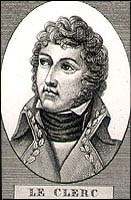Fact file
Born in Pontoise, 17 March 1772.
Volunteer in the 2e bataillon de Seine-et-Oise, lieutenant 19 Oct., 1791
Became one of the Adjudants généraux for the Armée d’Italie in 1793
Became Chief of Staff for the Division de l’Est (La Poype) in the army sent against Toulon, 1793
Adjudant général, Chef de bataillon, on 17 December, 1793: this nomination on the battlefield was confirmed by a decree passed by the Convention on 24 March, 1794
Detailed to the Armée des Alpes, took part in the attack on Mont Cenis, June 1794
Joined the Armée d’Italie in March, 1796
At the Battle of Castiglione, 5 August, 1796
At the Battle of Rivoli, 14 January, 1797
Sent to Ravenna, 3 February, 1797
Present at the crossing of the Piave, 12 March, 1797
Brought to Paris the Leoben peace preliminaries and the standards captured from the enemy, April 1797
Général de brigade, 6 May, 1797
Provisory Chief of Staff for the Armée d’Italie, 14 November, 1797
In the Armée de Rome in February, 1798
In the Armée d’Irlande, 2 November, 1798
Chief of Staff for the Armée d’Angleterre, 20 October, 1798
Général de division, 26 August, 1799
Joined the Armée de l’Ouest under Brune, in January 1800
Service in the Armée du Rhin, under Lecourbe, commander of the 7e division, 15 March, 1800
Service in the Armée du Rhin, under Moreau, commander of the 2e division of the Corps de Réserve, 1 April, 1800
Commander of the 2e Division du centre under Moreau, 8 June, 1800
At Hochstädt, 19 June, 1800
Took Landshut, June 1800
Replaced Gouvion Saint-Cyr at the head of the Corps auxiliaire sent to help the Spanish against Portugal, 15 March, 1801
Commander of the Corps d’observation of the Gironde, 18 March, 1801
Recalled to Paris, 8 October, 1801
Appointed Commander in Chief of the expedition to Santo Domingo, 24 October, 1801
Reached Brest, 19 November, 1801
Left Brest for Santo Domingo, 14 December, 1801
Reached the Bay of the Samara, 29 January, then disembarker at Cap Haïti, 6 February, 1802
Besieged the position called Pierrot’s ridge, from 4 to 22 March, 1802
Received the surrender of Toussaint-Louverture, 1 May, 1802, and then arrested him, 7 June, 1802
Died of yellow fever at Cap Français (Santo Domingo), 2 November, 1802
Born into an upper middle class family, Leclerc received a good education. He showed great sang-froid and courage during the First Italian Campaign, notably at Rivoli.
Coming into contact with Bonaparte as early as 1793 during the siege of Toulon, he married Napoleon’s sister, Paulette known as Pauline, 14 June, 1797, at Montebello near Milan. They had a son called Dermide (1798-1805).
He gave support to, and participated fully in, the Brumaire coup d’etat. The First Consul thereafter gave him ever broader powers, first in Germany and later in Spain.
24 October, 1801, Leclerc was appointed Commander in chief of the expedition to Santo Domingo and Capitain General of the colony. His mission was to bring calm to what was one of the richest colonies, but which had for many years been subject to civil strife, before being governed by the ‘black Bonaparte’, general Toussaint-Louverture.
The burning of the Cap by Christophe, one of Toussaint-Louverture’s right-hand men, marked the opening of the war, 5-6 February, 1802. Weakened by Leclerc’s victory at Pierrot’s ridge (during the course of March), the generals leading the insurrection surrendered one by one.
Toussaint-Louverture negociated his surrender, which he signed on 1 May, 1802. On 7 June, convinced of the rebel general’s duplicity, Leclerc enticed Toussaint-Louverture to a meeting with general Brunet under the pretext of a parley and had him arrested. The Haitian general was sent to France to be imprisoned in the Fort de Joux near Besançon in August 1802.
The way forward in terms of the reorganisation and success of the colony was seen in terms of the publication of a penal code, a new judiciary system and the shoring up of white plantation-holder power.
But the guerilla warfare continued and spread with the announcement that slavery would be re-introduced in August 1802, just at the moment when Leclerc was short of supplies and men, notably through yellow fever.
Facing a general attack by the rebel generals in September, Leclerc managed to save the Cap. But he was to die on 2 November, himself struck down by yellow fever.
The body of Leclerc – brought back by his wife, Pauline, who had followed him to Santo Domingo – was buried on 9 March, 1803 at Montgobert near Villers-Cotterêts.
His name appears on the west side of the Arc de Triomphe de l’Etoile.
On Saint Helena, Napoleon was to describe Leclerc as a “first rate officer, good both in the office and on the battlefield”.
I. Delage, September 2002, tr. P.H.
Bibliography
– H. Mézière: Le général Leclerc et l’expédition de Saint-Domingue, Tallandier, 1990
– P. Roussier: Lettres du général Leclerc, commandant en chef de l’armée de Saint-Domingue en 1802, 1937
– J. Tulard (dir.): Dictionnaire Napoléon, Fayard, 1999, 2e édition; s.v., Leclerc; Saint-Domingue; Toussaint-Louverture.
– G. Six: Dictionnaire biographique des généraux et amiraux de la Révolution et de l’Empire, Librairie G. Saffroy, 1934, reprinted 1995


